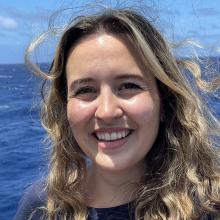
Jordana Cutajar
Tell us about your work/research. What kinds of things do you do?
My love for water led to a career in water quality with a focus on phytoplankton and harmful algal blooms (HABs) in urbanized fresh and coastal systems. For my thesis research, I investigated the water quality and phytoplankton composition of residential canals in Corpus Christi, Texas. These manmade systems are at the intersection of environmental and human health but are often overlooked and understudied. While these canals are desirable places to live, their unique designs (narrow enclosures, shallow depths, dead ends, etc.) and proximity to urbanized areas may inadvertently create equally desirable environments for HABs. As such I have spent a lot of time in the field taking water samples, working in laboratories, and looking at these amazing, tiny organisms under a microscope.
What sparked your initial interest in your career?
My career has been somewhat of a winding road that has consisted of me trying to blend my love for the social sciences with the “hard sciences”. I started out very passionate about environmental science and history, originally thinking I would become an environmental lawyer, but there was something missing. I figured law school would always be there and started getting more involved in lab and field work which ultimately led me to phytoplankton research. My fascination with phytoplankton only grew when I experienced my first red tide bloom in Fort Myers, Florida. My beloved childhood vacation spot looked apocalyptic with dead fish washing up on the abandoned beaches. From that moment I knew I wanted to research harmful algal blooms and try to find ways to work with community members to educate and prevent the spread of HABs.
Who influenced you or encouraged you the most?
My family was always very supportive of me growing up, but when I got to college, I had no idea what I wanted to do. While I was drawn to environmental science, I found it very intimidating. It wasn’t until I got involved with the Women’s Mentoring Program at the University of Florida, and met my amazing mentor, that I felt more curious and confident about exploring the sciences. She has helped me every step of the way and I probably would not be in a position if it wasn’t for her encouragement and support!
What element of your work/study do you think is the most fascinating?
I think phytoplankton have a bad reputation but when you look at them under a microscope, they are so beautiful! I get excited every time I spot a new diatom or dinoflagellate I’ve yet to identify, it always feels like a scavenger hunt to me. I got trained in scanning electron microscopy and was able to visualize phytoplankton at an extremely detailed level which led to some cool phytoplankton photos. There truly is a whole other world living in every drop of water!
What other jobs led you to your current career?
My first internship out of college with the Nature Coast Biological Station in Florida was instrumental in setting me up for an interdisciplinary career in the sciences. As part of my internship, I was able to help map the nutrients of the Suwannee River and its associated springs. The internship was the perfect blend of fieldwork, and research but I wanted to do more with science communication. Afterward, I worked as a lab and field biologist for a lake management company where I discovered my passion for phytoplankton. This passion eventually led me to pursue my master’s degree in Coastal and Marine System Science in Texas. During my master's, I finally got more involved in outreach via the Phytoplankton Monitoring Program – a citizen science initiative that empowers and supports community members to monitor their waterbodies for harmful algal blooms. I hope to continue working with communities on coastal issues as I get ready to graduate and become a NOAA Coastal Management Fellow.
What are your degrees and certifications?
Bachelor of Arts in Environmental Science -- University of Florida 2017
Master of Science – Texas A&M University-Corpus Christi 2022
What are your hobbies?
When I am not gushing over phytoplankton, I can be found embroidering them! I’ve also become addicted to roller skating and dream of joining a roller derby team. For other forms of escapism, I love traveling and listening to sappy audiobooks.
What advice would you give someone who wants to have a career like yours?
No matter what anyone tells you, science is for everyone! There is no “one way” to become a good scientist and the field needs people from all walks of life and educational backgrounds so don’t be afraid to throw your name in some hats! Throughout my journey, many people made me feel like I was not good enough to be a scientist and the more time I spent dwelling on that the more my imposter syndrome grew. While I think the field is evolving, it’s still important to seek out like-minded individuals who will believe in you and help foster resiliency because there will be a lot of setbacks! Academia can be challenging but everyone feels a bit of imposter syndrome now and then. I realized that was okay as long as I continued going after what I wanted.
How did you get involved with the Ocean Exploration Trust?
As a NOAA CCME scholar, I get email blasts about all the cool, new opportunities to work and intern with NOAA. I have always wanted to work on a research vessel, like the Nautilus so when I saw the ad for the Sea Floor Mapping Internship, I was instantly intrigued. I figured it was a long shot, but my NOAA co-mentor was very supportive and encouraged me to apply. I’m so happy I did!
Expeditions
Jordana participated in the following Ocean Exploration Trust expeditions:
